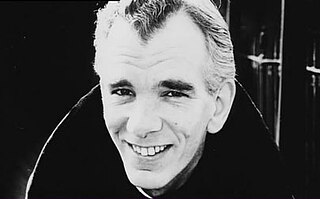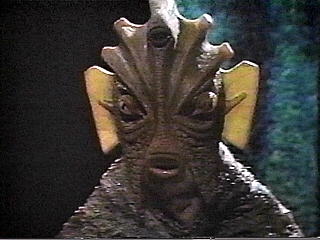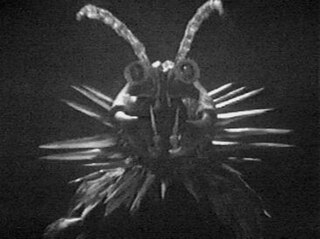
David Arthur Whitaker was an English television writer and novelist who worked on the early years of the science-fiction TV series Doctor Who. He served as the programme's first story editor, supervising the writing of its first 51 episodes from 1963 to 1964.

Invasion of the Dinosaurs, simply titled Invasion in Part One, is the second serial of the 11th season of the British science fiction television series Doctor Who, which was first broadcast in six weekly parts on BBC1 from 12 January to 16 February 1974.
Terror of the Autons is the first serial of the eighth season of the British science fiction television series Doctor Who. It was broadcast in four weekly parts on BBC1 from 2 to 23 January 1971.

Doctor Who and the Silurians is the second serial of the seventh season in the British science fiction television series Doctor Who. It was first broadcast in seven weekly parts on BBC1 from 31 January to 14 March 1970.
Day of the Daleks is the first serial of the ninth season of the British science fiction television series Doctor Who, which was first broadcast in four weekly parts from 1 to 22 January 1972. It was the first of four Third Doctor serials to feature the Daleks, which returned to the series for the first time since The Evil of the Daleks (1967).
Doctor Who spin-offs refers to material created outside of, but related to, the long-running British science fiction television series Doctor Who.

The Dalek Invasion of Earth is the second serial of the second season in the British science fiction television series Doctor Who. Written by Terry Nation and directed by Richard Martin, the serial was broadcast on BBC1 in six weekly parts from 21 November to 26 December 1964. In the serial, the First Doctor, his granddaughter Susan Foreman, and teachers Ian Chesterton and Barbara Wright discover that the Earth in the 22nd century has been occupied by Daleks. They work with a human resistance group to stop the Daleks from mining out the Earth's core as part of their plan to pilot the planet through space.
Pyramids of Mars is the third serial of the 13th season of the British science fiction television series Doctor Who. Written by Robert Holmes and Lewis Greifer under the pseudonym of "Stephen Harris" and directed by Paddy Russell, the serial was first broadcast in four weekly parts on BBC1 from 25 October to 15 November 1975.
Silver Nemesis is the third serial of the 25th season of the British science fiction television series Doctor Who. It was first broadcast in the United Kingdom on BBC1 in three weekly parts from 23 November to 7 December 1988. In New Zealand, all three parts were broadcast on TVNZ on 25 November.
The Dominators is the first serial of the sixth season of the British science fiction television series Doctor Who, which originally aired in five weekly parts from 10 August to 7 September 1968. The Second Doctor and his travelling companions Jamie McCrimmon and Zoe Heriot work with the Dulcians of the planet Dulkis to prevent the alien Dominators from blowing up Dulkis and using its irradiated remains as spaceship fuel.

The Sensorites is the seventh serial in the British science fiction television series Doctor Who. Written by Peter R. Newman and directed by Mervyn Pinfield and Frank Cox, the serial was first broadcast on BBC1 in six weekly parts from 20 June to 1 August 1964. In the serial, the First Doctor, his granddaughter Susan Foreman, and her teachers Ian Chesterton and Barbara Wright visit a planet known as the Sense-Sphere to find the cure to a disease afflicting the alien race the Sensorites.
Resurrection of the Daleks is the fourth serial of the 21st season in the British science fiction television series Doctor Who, which was first broadcast in two weekly parts on BBC1 between 8 February and 15 February 1984. The serial was intended to be transmitted as four 23-minute episodes but a late scheduling change by the BBC meant that it was transmitted as two episodes of 46 minutes; reruns restored it to its intended format.
Terror of the Zygons is the first serial of the thirteenth season of the British science fiction television series Doctor Who, which was the first broadcast in four weekly parts on BBC1 from 30 August to 20 September 1975. The serial featured the last regular appearance by Ian Marter as companion Harry Sullivan and Nicholas Courtney as Brigadier Lethbridge-Stewart.

The Rescue is the third serial of the second season of the British science fiction television series Doctor Who. Written by outgoing story editor David Whitaker and directed by Christopher Barry, the serial was broadcast on BBC1 in two weekly parts on 2 January and 9 January 1965. In the serial, the time travellers the First Doctor, Ian Chesterton, and Barbara Wright befriend Vicki, an orphan girl marooned on the planet Dido who is being threatened by an apparent native of Dido called Koquillion while awaiting rescue.

The Chase is the eighth serial of the second season in the British science fiction television series Doctor Who. Written by Terry Nation and directed by Richard Martin, the serial was broadcast on BBC in six weekly parts from 22 May to 26 June 1965. Set in multiple time periods on several different planets, including Aridius, Earth, and Mechanus, the serial features the Dalek race travelling through time while pursuing the TARDIS and its occupants—the First Doctor and his companions Ian Chesterton, Barbara Wright, and Vicki —to kill them and seize the TARDIS for themselves. The Doctor and companions encounter several characters, including monsters Dracula and Frankenstein's monster, human astronaut Steven Taylor, and an android replica of the Doctor.
Death to the Daleks is the third serial of the 11th season of the British science fiction television series Doctor Who, which was first broadcast in four weekly parts on BBC1 from 23 February to 16 March 1974.
The Monster of Peladon is the fourth serial of the 11th season of the British science fiction television series Doctor Who, which was first broadcast in six weekly parts on BBC1 from 23 March to 27 April 1974. It was Jon Pertwee's penultimate serial as the Third Doctor.
The Ambassadors of Death is the third serial of the seventh season of the British science fiction television series Doctor Who, which was first broadcast in seven weekly parts on BBC1 from 21 March to 2 May 1970. Written by Trevor Ray, Terrance Dicks and Malcolm Hulke, the serial was directed by Michael Ferguson.

The twelfth season of British science fiction television series Doctor Who began on 28 December 1974 with Tom Baker's first serial Robot, and ended with Revenge of the Cybermen on 10 May 1975.











